Abstract
The production of glycoproteins with carbohydrates of defined structure and minimal heterogeneity is important for functional studies of mammalian carbohydrates. To facilitate such studies, several Chinese hamster ovary mutants that carry between two and four glycosylation mutations were developed. All of the lines grew readily in culture despite the drastic simplification of their surface carbohydrates. Therefore, both endogenous glycoproteins and those introduced by transfection can be obtained with specifically tailored carbohydrates. The lectin resistance properties of the mutants showed that each line expresses a novel array of cell surface carbohydrates useful for identifying specific roles for carbohydrates in cellular interactions. In addition, they showed that the epistatic relationships among different glycosylation mutations are not entirely predictable, providing insight into the complexity of the carbohydrate structures at the Chinese hamster ovary cell surface.
Full text
PDF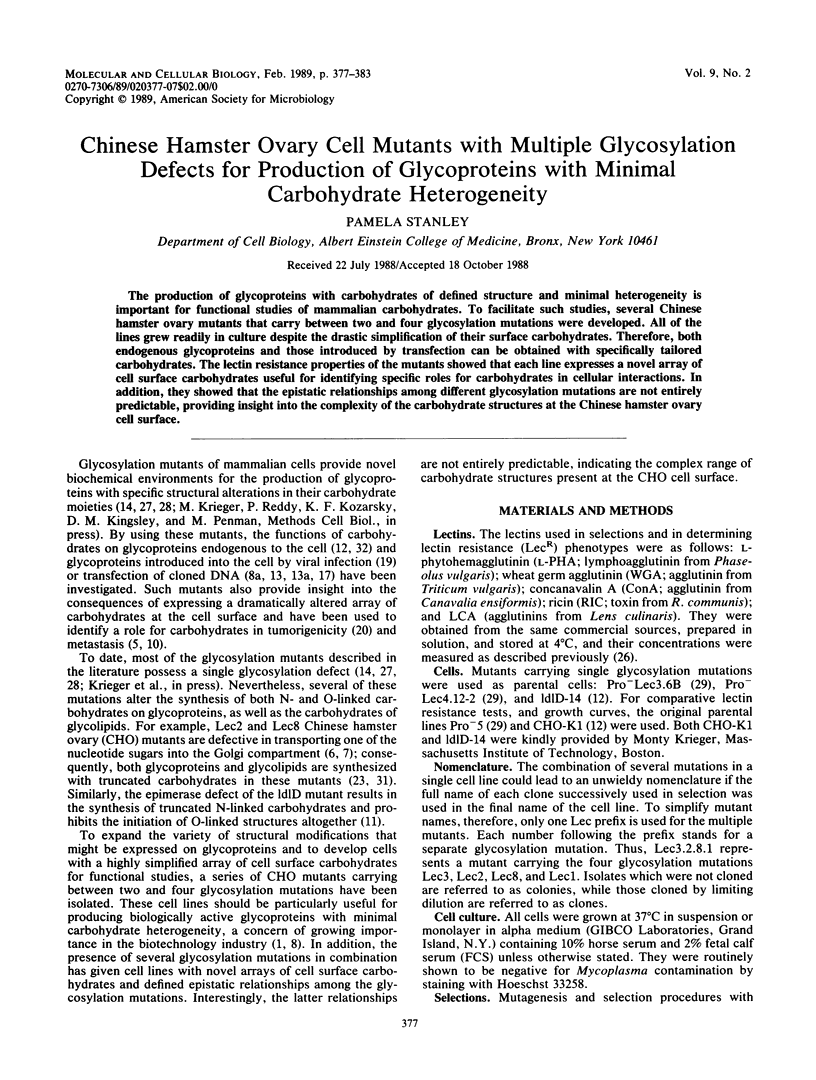
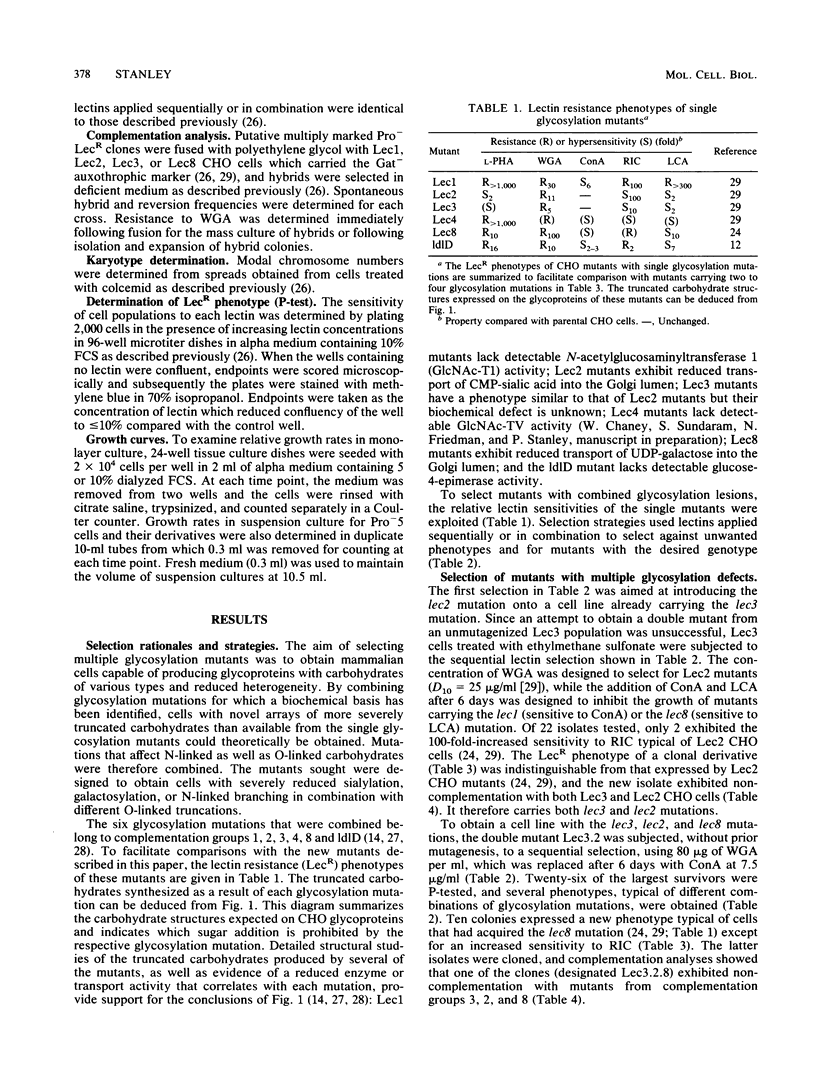
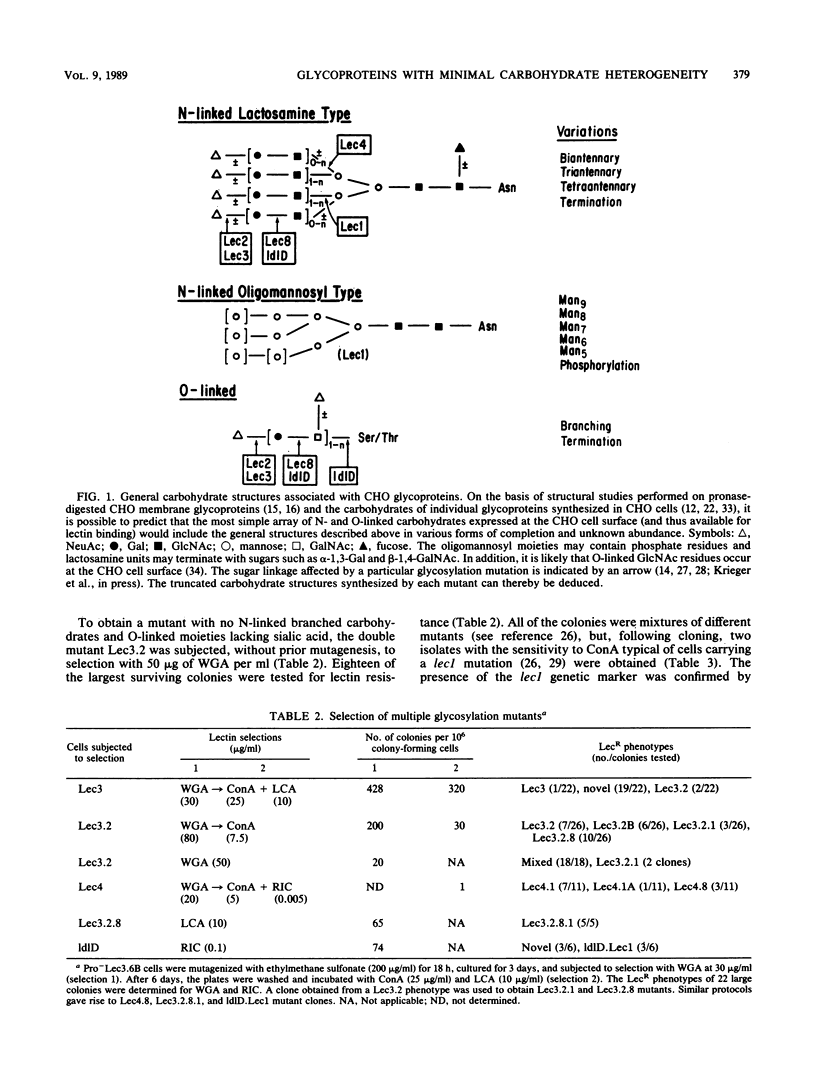
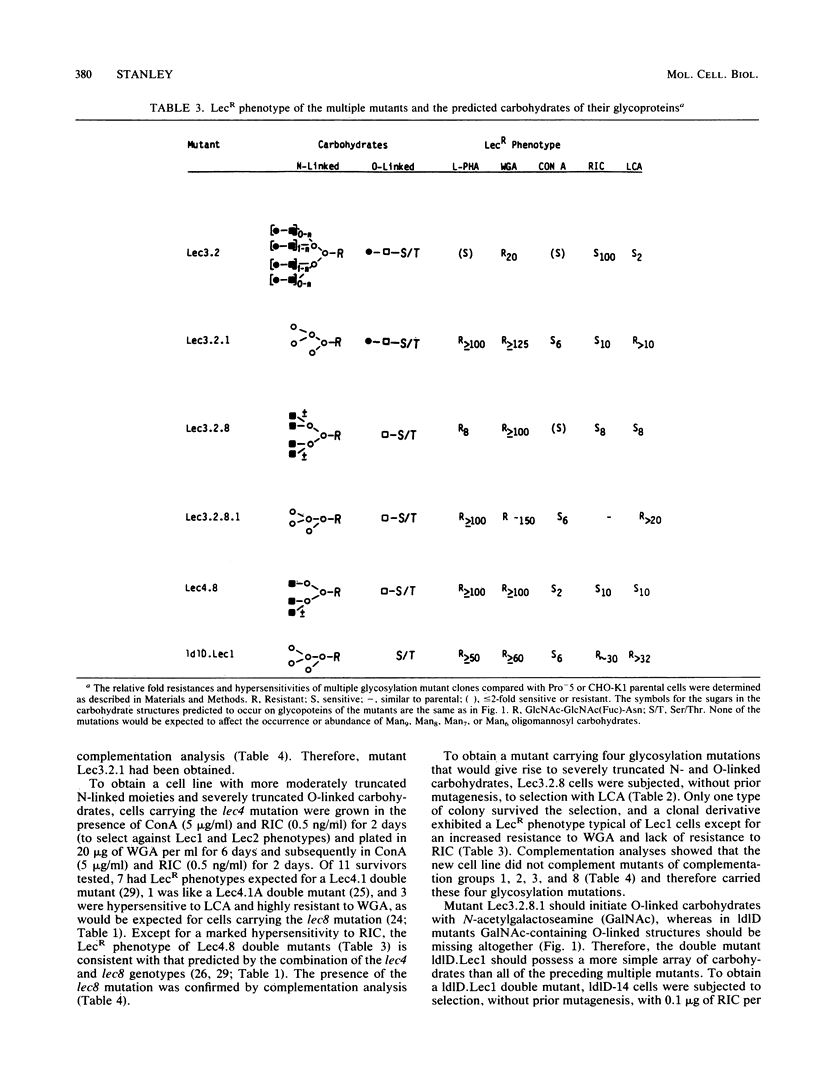
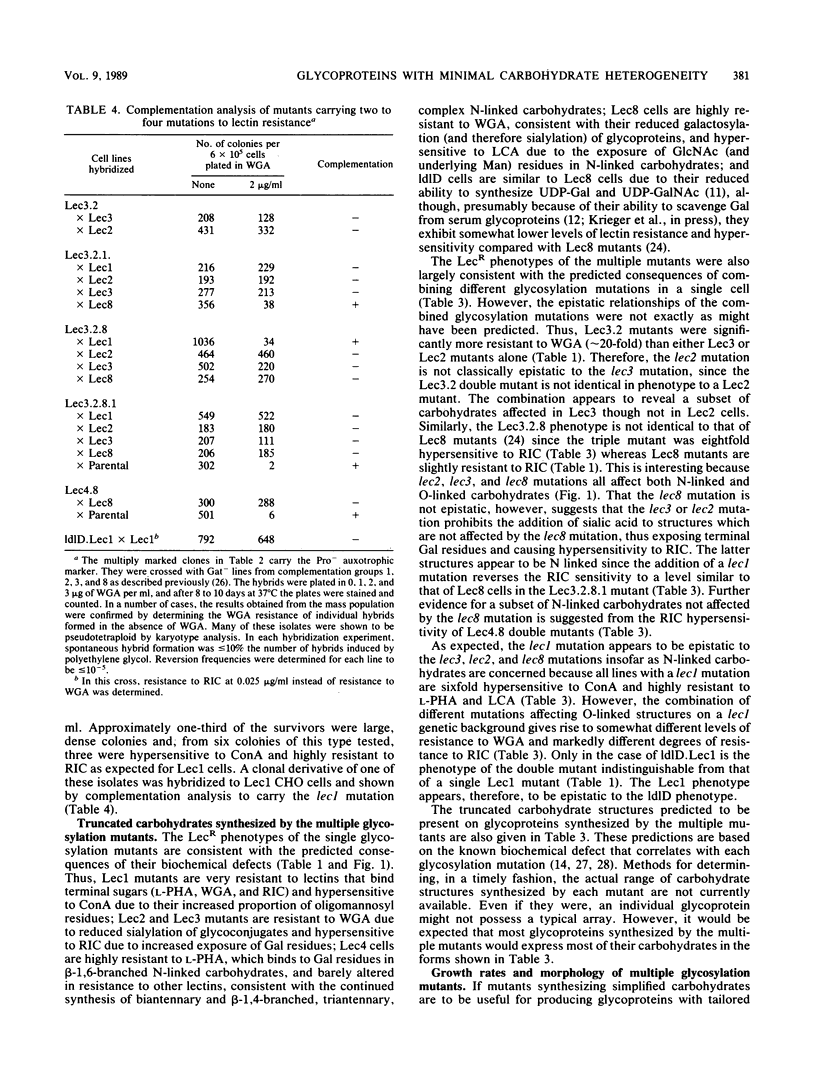
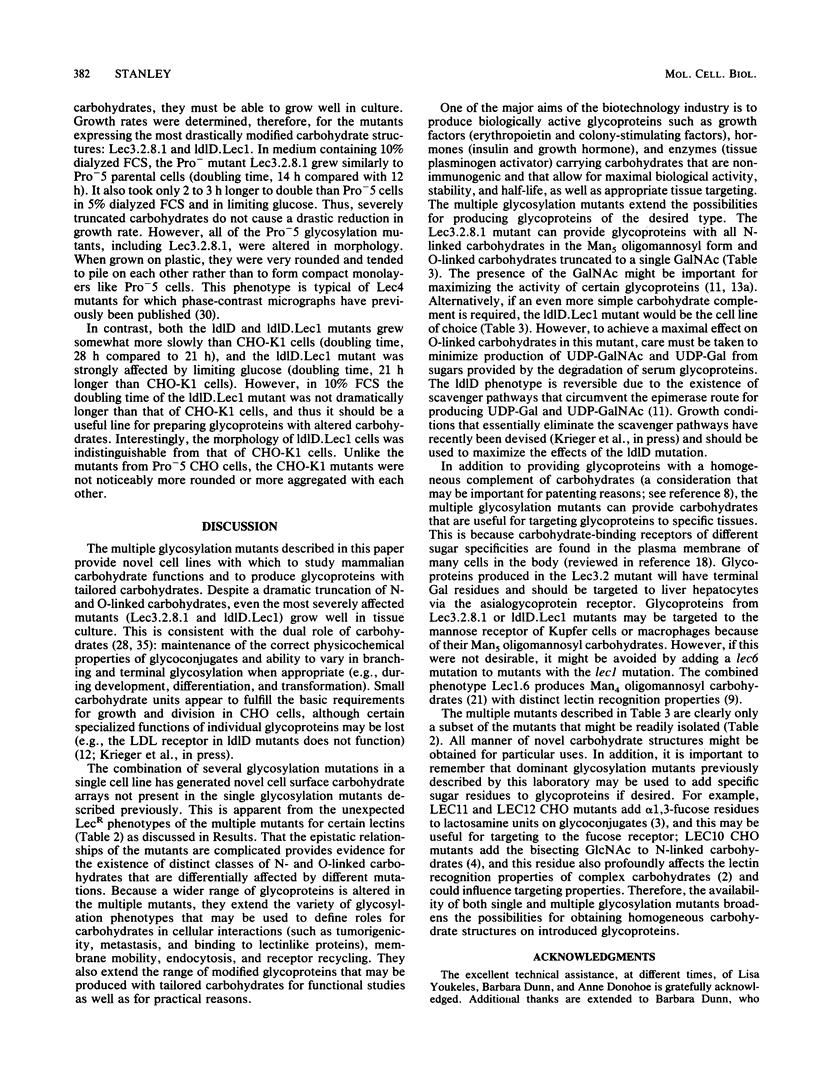
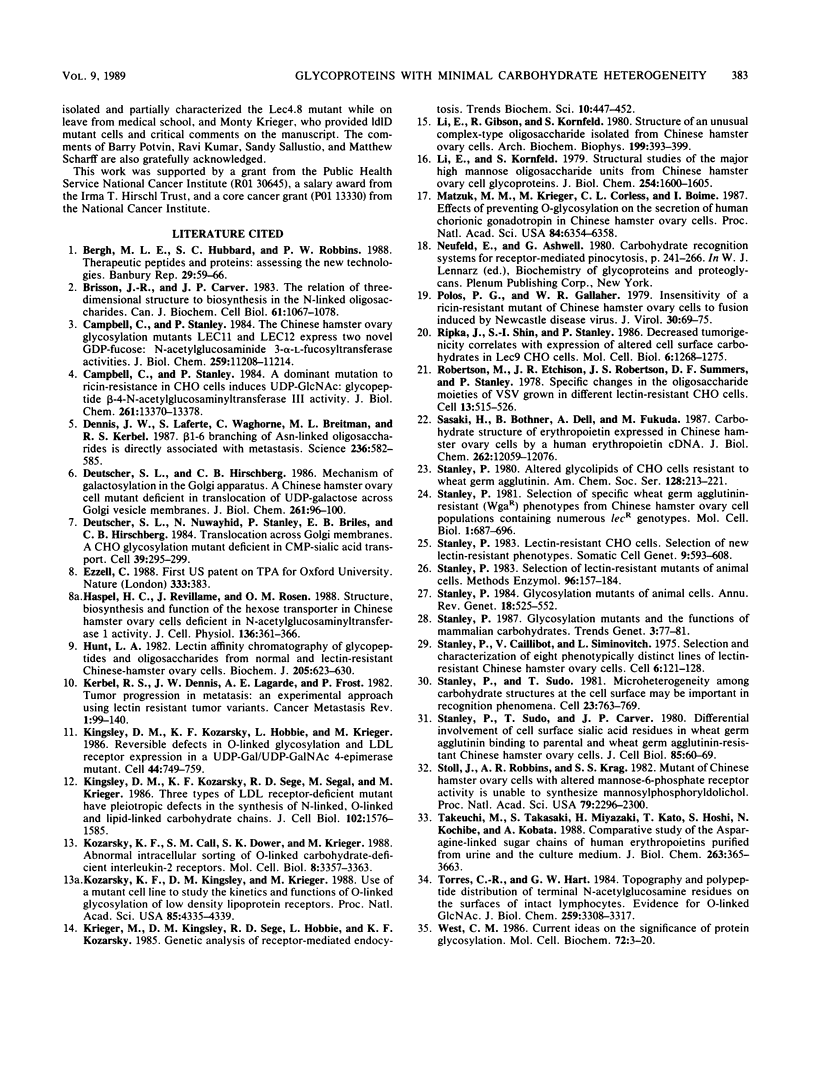
Selected References
These references are in PubMed. This may not be the complete list of references from this article.
- Brisson J. R., Carver J. P. The relation of three-dimensional structure to biosynthesis in the N-linked oligosaccharides. Can J Biochem Cell Biol. 1983 Sep;61(9):1067–1078. doi: 10.1139/o83-135. [DOI] [PubMed] [Google Scholar]
- Campbell C., Stanley P. A dominant mutation to ricin resistance in Chinese hamster ovary cells induces UDP-GlcNAc:glycopeptide beta-4-N-acetylglucosaminyltransferase III activity. J Biol Chem. 1984 Nov 10;259(21):13370–13378. [PubMed] [Google Scholar]
- Campbell C., Stanley P. The Chinese hamster ovary glycosylation mutants LEC11 and LEC12 express two novel GDP-fucose:N-acetylglucosaminide 3-alpha-L-fucosyltransferase enzymes. J Biol Chem. 1984 Sep 25;259(18):11208–11214. [PubMed] [Google Scholar]
- Dennis J. W., Laferté S., Waghorne C., Breitman M. L., Kerbel R. S. Beta 1-6 branching of Asn-linked oligosaccharides is directly associated with metastasis. Science. 1987 May 1;236(4801):582–585. doi: 10.1126/science.2953071. [DOI] [PubMed] [Google Scholar]
- Deutscher S. L., Hirschberg C. B. Mechanism of galactosylation in the Golgi apparatus. A Chinese hamster ovary cell mutant deficient in translocation of UDP-galactose across Golgi vesicle membranes. J Biol Chem. 1986 Jan 5;261(1):96–100. [PubMed] [Google Scholar]
- Deutscher S. L., Nuwayhid N., Stanley P., Briles E. I., Hirschberg C. B. Translocation across Golgi vesicle membranes: a CHO glycosylation mutant deficient in CMP-sialic acid transport. Cell. 1984 Dec;39(2 Pt 1):295–299. doi: 10.1016/0092-8674(84)90007-2. [DOI] [PubMed] [Google Scholar]
- Ezzell C. First US patent on TPA for Oxford University. Nature. 1988 Jun 2;333(6172):383–383. doi: 10.1038/333383a0. [DOI] [PubMed] [Google Scholar]
- Haspel H. C., Revillame J., Rosen O. M. Structure, biosynthesis, and function of the hexose transporter in Chinese hamster ovary cells deficient in N-acetylglucosaminyltransferase 1 activity. J Cell Physiol. 1988 Aug;136(2):361–366. doi: 10.1002/jcp.1041360221. [DOI] [PubMed] [Google Scholar]
- Hunt L. A. Lectin affinity chromatography of glycopeptides and oligosaccharides from normal and lectin-resistant Chinese-hamster ovary cells. Biochem J. 1982 Sep 1;205(3):623–630. doi: 10.1042/bj2050623. [DOI] [PMC free article] [PubMed] [Google Scholar]
- Kerbel R. S., Dennis J. W., Largarde A. E., Frost P. Tumor progression in metastasis: an experimental approach using lectin resistant tumor variants. Cancer Metastasis Rev. 1982;1(2):99–140. doi: 10.1007/BF00048223. [DOI] [PubMed] [Google Scholar]
- Kingsley D. M., Kozarsky K. F., Hobbie L., Krieger M. Reversible defects in O-linked glycosylation and LDL receptor expression in a UDP-Gal/UDP-GalNAc 4-epimerase deficient mutant. Cell. 1986 Mar 14;44(5):749–759. doi: 10.1016/0092-8674(86)90841-x. [DOI] [PubMed] [Google Scholar]
- Kingsley D. M., Kozarsky K. F., Segal M., Krieger M. Three types of low density lipoprotein receptor-deficient mutant have pleiotropic defects in the synthesis of N-linked, O-linked, and lipid-linked carbohydrate chains. J Cell Biol. 1986 May;102(5):1576–1585. doi: 10.1083/jcb.102.5.1576. [DOI] [PMC free article] [PubMed] [Google Scholar]
- Kozarsky K. F., Call S. M., Dower S. K., Krieger M. Abnormal intracellular sorting of O-linked carbohydrate-deficient interleukin-2 receptors. Mol Cell Biol. 1988 Aug;8(8):3357–3363. doi: 10.1128/mcb.8.8.3357. [DOI] [PMC free article] [PubMed] [Google Scholar]
- Kozarsky K., Kingsley D., Krieger M. Use of a mutant cell line to study the kinetics and function of O-linked glycosylation of low density lipoprotein receptors. Proc Natl Acad Sci U S A. 1988 Jun;85(12):4335–4339. doi: 10.1073/pnas.85.12.4335. [DOI] [PMC free article] [PubMed] [Google Scholar]
- Li E., Gibson R., Kornfeld S. Structure of an unusual complex-type oligosaccharide isolated from Chinese hamster ovary cells. Arch Biochem Biophys. 1980 Feb;199(2):393–399. doi: 10.1016/0003-9861(80)90295-7. [DOI] [PubMed] [Google Scholar]
- Li E., Kornfeld S. Structural studies of the major high mannose oligosaccharide units from Chinese hamster ovary cell glycoproteins. J Biol Chem. 1979 Mar 10;254(5):1600–1605. [PubMed] [Google Scholar]
- Matzuk M. M., Krieger M., Corless C. L., Boime I. Effects of preventing O-glycosylation on the secretion of human chorionic gonadotropin in Chinese hamster ovary cells. Proc Natl Acad Sci U S A. 1987 Sep;84(18):6354–6358. doi: 10.1073/pnas.84.18.6354. [DOI] [PMC free article] [PubMed] [Google Scholar]
- Polos P. G., Gallaher W. R. Insensitivity of a ricin-resistant mutant of Chinese hamster ovary cells to fusion induced by Newcastle disease virus. J Virol. 1979 Apr;30(1):69–75. doi: 10.1128/jvi.30.1.69-75.1979. [DOI] [PMC free article] [PubMed] [Google Scholar]
- Ripka J., Shin S., Stanley P. Decreased tumorigenicity correlates with expression of altered cell surface carbohydrates in Lec9 CHO cells. Mol Cell Biol. 1986 Apr;6(4):1268–1275. doi: 10.1128/mcb.6.4.1268. [DOI] [PMC free article] [PubMed] [Google Scholar]
- Robertson M. A., Etchison J. R., Robertson J. S., Summers D. F., Stanley P. Specific changes in the oligosaccharide moieties of VSV grown in different lectin-resistnat CHO cells. Cell. 1978 Mar;13(3):515–526. doi: 10.1016/0092-8674(78)90325-2. [DOI] [PubMed] [Google Scholar]
- Sasaki H., Bothner B., Dell A., Fukuda M. Carbohydrate structure of erythropoietin expressed in Chinese hamster ovary cells by a human erythropoietin cDNA. J Biol Chem. 1987 Sep 5;262(25):12059–12076. [PubMed] [Google Scholar]
- Stanley P., Caillibot V., Siminovitch L. Selection and characterization of eight phenotypically distinct lines of lectin-resistant Chinese hamster ovary cell. Cell. 1975 Oct;6(2):121–128. doi: 10.1016/0092-8674(75)90002-1. [DOI] [PubMed] [Google Scholar]
- Stanley P. Glycosylation mutants of animal cells. Annu Rev Genet. 1984;18:525–552. doi: 10.1146/annurev.ge.18.120184.002521. [DOI] [PubMed] [Google Scholar]
- Stanley P. Lectin-resistant CHO cells: selection of new mutant phenotypes. Somatic Cell Genet. 1983 Sep;9(5):593–608. doi: 10.1007/BF01574260. [DOI] [PubMed] [Google Scholar]
- Stanley P. Selection of lectin-resistant mutants of animal cells. Methods Enzymol. 1983;96:157–184. doi: 10.1016/s0076-6879(83)96015-9. [DOI] [PubMed] [Google Scholar]
- Stanley P. Selection of specific wheat germ agglutinin-resistant (WgaR) phenotypes from Chinese hamster ovary cell populations containing numerous lecR genotypes. Mol Cell Biol. 1981 Aug;1(8):687–696. doi: 10.1128/mcb.1.8.687. [DOI] [PMC free article] [PubMed] [Google Scholar]
- Stanley P., Sudo T., Carver J. P. Differential involvement of cell surface sialic acid residues in wheat germ agglutinin binding to parental and wheat germ agglutinin-resistant Chinese hamster ovary cells. J Cell Biol. 1980 Apr;85(1):60–69. doi: 10.1083/jcb.85.1.60. [DOI] [PMC free article] [PubMed] [Google Scholar]
- Stanley P., Sudo T. Microheterogeneity among carbohydrate structures at the cell surface may be important in recognition phenomena. Cell. 1981 Mar;23(3):763–769. doi: 10.1016/0092-8674(81)90440-2. [DOI] [PubMed] [Google Scholar]
- Stoll J., Robbins A. R., Krag S. S. Mutant of Chinese hamster ovary cells with altered mannose 6-phosphate receptor activity is unable to synthesize mannosylphosphoryldolichol. Proc Natl Acad Sci U S A. 1982 Apr;79(7):2296–2300. doi: 10.1073/pnas.79.7.2296. [DOI] [PMC free article] [PubMed] [Google Scholar]
- Takeuchi M., Takasaki S., Miyazaki H., Kato T., Hoshi S., Kochibe N., Kobata A. Comparative study of the asparagine-linked sugar chains of human erythropoietins purified from urine and the culture medium of recombinant Chinese hamster ovary cells. J Biol Chem. 1988 Mar 15;263(8):3657–3663. [PubMed] [Google Scholar]
- Torres C. R., Hart G. W. Topography and polypeptide distribution of terminal N-acetylglucosamine residues on the surfaces of intact lymphocytes. Evidence for O-linked GlcNAc. J Biol Chem. 1984 Mar 10;259(5):3308–3317. [PubMed] [Google Scholar]
- West C. M. Current ideas on the significance of protein glycosylation. Mol Cell Biochem. 1986 Nov-Dec;72(1-2):3–20. doi: 10.1007/BF00230632. [DOI] [PMC free article] [PubMed] [Google Scholar]


